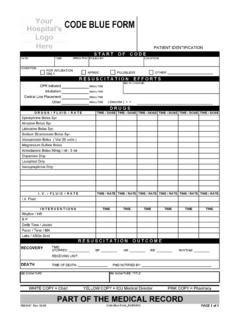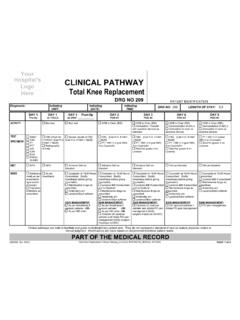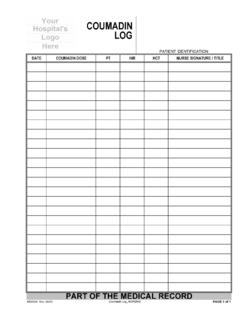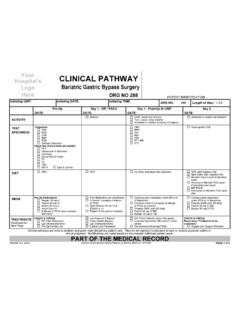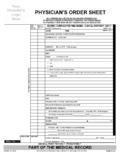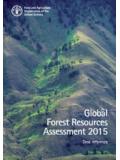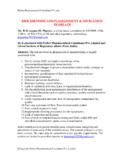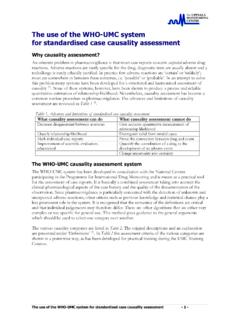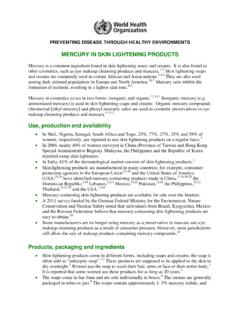Transcription of NEUROLOGICAL ASSESSMENT FLOW SHEET - …
1 NEUROLOGICAL . ASSESSMENT . FLOW SHEET . PATIENT IDENTIFICATION. DATE: TIME: (Military Time). EYES 4= SPONTANEOUS. OPEN 3= To SPEECH. 2= To PAIN. 1= NONE. C= Eyes CLOSED by Edema BEST 5= ORIENTED. VERBAL 4= CONFUSED. RESPONSE 3= Inappropriate WORDS. 2= Incomprehend. SOUNDS. 1= NONE. T= ET / Trach BEST 6= Obeys Commands MOTOR 5= LOCALIZES (Pain). RESPONSE 4= WITHDRAWS (Pain). 3= FLEXION (Pain). 2= EXTENSION (Pain). 1= NONE. GLASCOW COMA SCALE TOTAL: PUPIL RIGHT SIZE: REACTION REACTION: EXTREMITIES: Record RIGHT ("R") and 1 2 3 4 5 6 7 8 B = BRISK N = NO REACTION LEFT ("L") if there is a difference between S = SLUGGISH C = EYES CLOSED the two sides. PUPIL LEFT SIZE: REACTION REACTION: ARMS NP = Normal Power W = Weakness NR = No Response LEGS NP = Normal Power W = Weakness NR = No Response REFLEXES CORNEAL: P = PRESENT GAG: A = ABSENT BABINSKI: ( See Reverse ) SEIZURE ACTIVITY: ( See Reverse ) BREATHING PATTERN: INTIALS: PART OF THE MEDICAL RECORD.
2 8850319 Rev. 05/05 NEUROLOGICAL ASSESSMENT Flow Sheet_NURSING PAGE 1 of 2. INITIAL SIGNATURE INITIAL SIGNATURE. SEIZURE ACTIVITY DESCRIPTION. 1. FOCAL No loss of consciousness; may involve motor, sensory and / or autonomic symptoms. 2. PSYCHOMOTOR, May be preceded by an aura. At onset of seizure, there will be a consciousness change. TEMPORAL LOBE Ends with a post-ictal period. 3. ATONIC -or- AKINETIC Sudden loss of body tone -or- body movement. 4. PETIT MAL Sudden onset and cessation -or- loss of responsiveness; no post-ictal symptoms. Or tonic-clonic seizures. Pre-ictal symptoms may involve focal seizure. Loss of 5. GRAND MAL consciousness at onset of seizure with increased muscle tone ( rigid flexed and rigid extended postures ). Bilateral rhythmic jerks follow and become further apart. Post- ictal period follows.
3 6. STATUS Generalized tonic-clonic seizure lasting longer than 30 minutes -or- failure of patient EPILEPTICUS to regain consciousness between a series of seizures. BREATHING PATTERN DESCRIPTION. 1. TACHYPNEA Increased frequency of breathing. 2. APNEA Cessation of respirations. 3. GASPING Spasmodic respiratory effort, may be regular or irregular. 4. CHEYNE - STROKES Cycles of gradually increasing tidal volume, followed by gradual decreasing tida volume. DESCRIPTIVE TERMS FOR LEVEL OF CONSCIOUSNESS. TERM DESCRIPTION. 1. ALERT Responds immediately and fully to visual, auditory or tactile stimulation. 2. LETHARGIC Drowsy, sleeps a lot, but is easily aroused and then responds to visual, auditory or tactile stimulation. 3. OBTUNDED Can be aroused by stimuli ( not painful ); will then respond to questions or commands.
4 Remains aroused as long as stimulus is applied. During the arousal, patient responds but may be confused. 4. STUPOROUS Very hard to arouse. Looks around when stimulated. May obey commands at times. May curse or say "don't" when stimulated. 5. SEMICOMATOSE Purposeful movements when stimulated. Does not obey commands or answer questions. Does not talk at all. 6. COMA Decorticate: draws hands up onto chest when stimulated, but not purposely. Decerebrate: extends arms and legs, arches neck and internally rotates hands and arms when stimulated. Unresponsive: no response to any stimuli. PART OF THE MEDICAL RECORD. 8850319 Rev. 05/05 NEUROLOGICAL ASSESSMENT Flow Sheet_NURSING PAGE 2 of 2.

